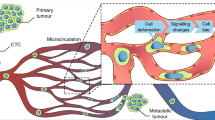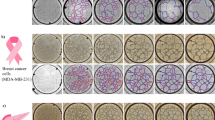Abstract
Angiogenesis, the growth of new blood vessels, occurs normally during osteogenesis, luteinisation and the development of the embryo, and in pathological states such as chronic inflammation, certain immune reactions and neoplasia1. Furthermore, solid tumours have been reported to secrete a diffusible factor which promotes the directional growth of new capillaries towards a growing tumour2. Two events required for the formation of a new capillary in response to an angiogenesis factor in vivo are the migration and subsequent proliferation of capillary endothelial cells3. Progress in purifying angiogenesis factors and studying their action has been hindered, however, by the lack of quantitative in vitro assays for capillary cell migration and proliferation. Recently, we have been able to isolate clonal cell lines of bovine capillary endothelial cells that can be maintained in long-term culture using tumour-conditioned growth medium4. I now report a quantitative in vitro assay for endothelial cell migration based on the phagokinetic track assay of Albrecht-Buehler5. The evidence presented here demonstrates that tumour-derived factors stimulate the migration of capillary endothelial cells whereas the same factors have no effect on the migration of aortic endothelial cells.
This is a preview of subscription content, access via your institution
Access options
Subscribe to this journal
Receive 51 print issues and online access
$199.00 per year
only $3.90 per issue
Buy this article
- Purchase on Springer Link
- Instant access to full article PDF
Prices may be subject to local taxes which are calculated during checkout
Similar content being viewed by others
References
Folkman, J. & Cotran, R. Int. Rev. exp. Path. 16, 207–248 (1976).
Folkman, J., Merler, E., Abernathy, C. & Williams, G. J. exp. Med. 133, 275–288 (1971).
Ausprunk, D. H. & Folkman, J. Microvascular Res. 14, 53–65 (1977).
Folkman, J., Haudenschild, C. & Zetter, B. R. Proc. natn. Acad. Sci. U.S.A. 76, 5217–5221 (1979).
Albrecht–Buehler, G. Cell 11, 395–404 (1977); J. Cell Biol. 72, 595–603 (1977).
Ali, I. U. & Hynes, R. O. Cell 14, 439–446 (1978).
Pouyssegur, J. & Pastan, I. Expl Cell Res. 121, 373–382 (1979).
Brouty-Boyé, D. & Zetter, B. R. Science (in the press).
Author information
Authors and Affiliations
Rights and permissions
About this article
Cite this article
Zetter, B. Migration of capillary endothelial cells is stimulated by tumour-derived factors. Nature 285, 41–43 (1980). https://doi.org/10.1038/285041a0
Received:
Accepted:
Issue Date:
DOI: https://doi.org/10.1038/285041a0
This article is cited by
-
A Moving Mesh Method for Mathematical Model of Capillary Formation in Tumor Angiogenesis
Iranian Journal of Science and Technology, Transactions A: Science (2019)
-
RETRACTED ARTICLE: Isolation and characterization of goat retinal microvascular endothelial cells
In Vitro Cellular & Developmental Biology - Animal (2010)
-
Role of Chemokines in Angiogenesis: CXCL12/SDF‐1 and CXCR4 Interaction, a Key Regulator of Endothelial Cell Responses
Microcirculation (2003)
-
Identification of an angiogenic mitogen selective for endocrine gland endothelium
Nature (2001)
-
Effect of Angiogenic and Antiangiogenic Compounds on the Outgrowth of Capillary Structures from Fetal Mouse Bone Explants
Laboratory Investigation (2001)
Comments
By submitting a comment you agree to abide by our Terms and Community Guidelines. If you find something abusive or that does not comply with our terms or guidelines please flag it as inappropriate.



